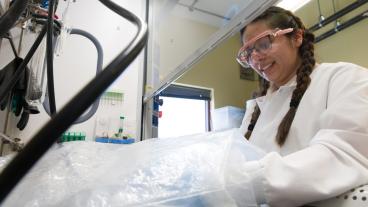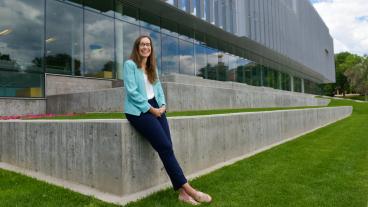In the lobby of the Green Center at Mines, a nicely dressed graduate student described fatigue tests for wind turbine blades while pointing at a large poster filled with colorful diagrams. Nearby another student explained carbon isotope chemostratigraphy of the Niobrara shale formation. Another analyzed the geochemistry of a volcanic hydrothermal system at Mount Spurr, Alaska.
Held in March, the occasion was the 2012 Conference on Earth Energy Research (CEER), one of the largest events sponsored by the Colorado School of Mines Graduate Student Association (GSA).
“As graduate students, one of the things we’re really focused on is making sure the novel ideas and research we work on are discussed collaboratively in the public domain,” said Chemical Engineering Graduate Student Zach Aman, president of the GSA, co-coordinator of CEER and a recent recipient of a Best Student Poster Award at the Gordon Research Conference on Natural Gas Hydrate Systems.
CEER brought in over 160 participants from around the nation to share new ideas on earth and energy issues. Eighty judges, comprised of faculty, alumni and industry representatives judged the presentations in real-time using custom-designed software on an iPad or laptop — a first for graduate research conferences in the U.S.
The judges evaluated not only scientific merit, but how well the grad students communicated their work.
“It’s about understanding your audience, communicating at the level of your audience, and being able to discuss your research regardless who you’re talking to,” said Cericia Martinez, vice president of the graduate student association and CEER conference chair.
CEER presents just one example of the bold leadership of Mines graduate students. Mines’ GSA continues to set standards for graduate student associations nationally — it is one of the most independent, well-funded graduate student groups in the nation. This allows the group to offer travel grants for students to attend conferences, bring interdisciplinary lectures to campus and assist graduate students who have lost funding. Through a partnership with the Colorado School of Mines Alumni Association, GSA’s graduate continuance fellowship provides $5,000 in tuition and $4,000 in living expense assistance. It’s a first of its kind in the U.S.
“We are very proud of the fact that, as compared to many universities around the country, the GSA at Mines gets tremendous support from both the students and the faculty. We have a very strong and well-defined graduate structure,” said Aman. “Because of this, we are able to offer innovative, cutting-edge programs to address the needs of this graduate population.”
This article appears in the 2012-13 issue of Energy and the Earth magazine.



